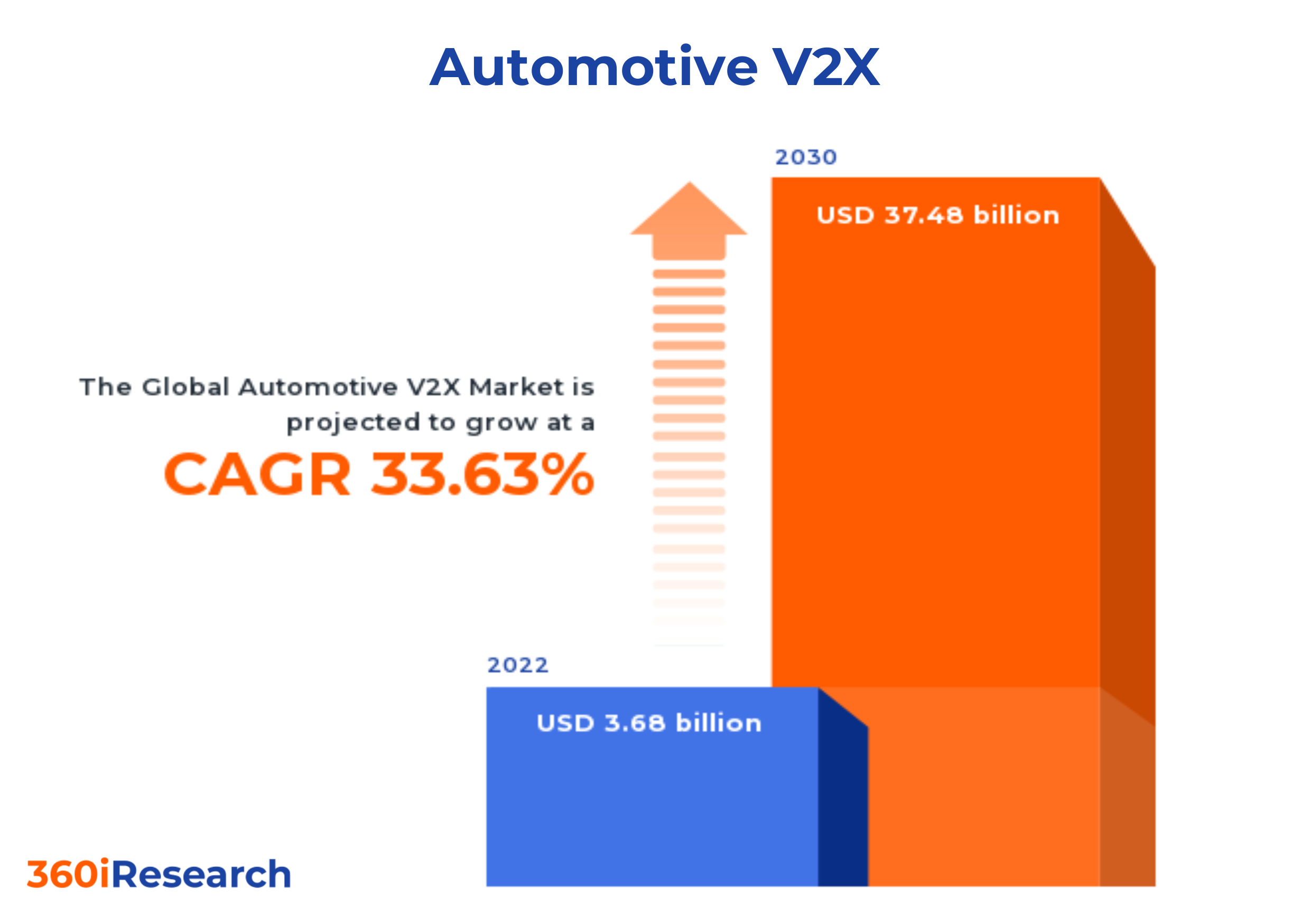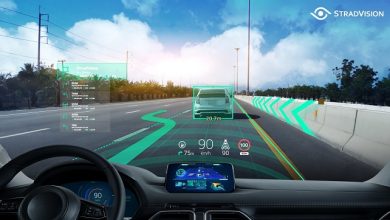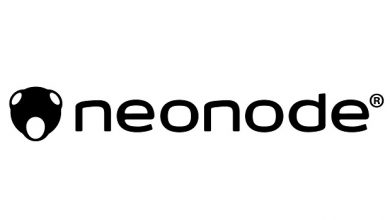Automotive V2X market to hit $37.48B by 2030 at 33.63% CAGR

PUNE, MAHARASHTRA, INDIA, November 10, 2023 /EINPresswire.com/ — The “Automotive V2X Market by Communication Type (Vehicle-to-Cloud, Vehicle-to-Device, Vehicle-to-Grid), Connectivity (Cellular-V2X Communication, Dedicated Short-Range Communication), Offering, Vehicle Type – Global Forecast 2023-2030″ report has been added to 360iResearch.com’s offering.
The Global Automotive V2X Market is projected to grow from USD 3.68 billion in 2022 to USD 37.48 billion by 2030. This growth represents a Compound Annual Growth Rate (CAGR) of 33.63%.
Automotive vehicle-to-everything (V2X) technology enables communication between a vehicle, reducing the possibilities of any entity or other vehicle get affected. This technology utilizes sensors, cameras, and wireless connectivity, allowing cars to associate with and communicate with their drivers and surroundings. V2X technology enables real-time data transmission using wireless communication protocols, such as dedicated short-range communication (DSRC) or cellular vehicle-to-everything (C-V2X). Vehicle-to-everything, or V2X solutions, connect road users and the infrastructure. The rising adoption of connected cars, rapid urbanization, and industrialization drive the market. The increasing demand for cloud-based V2X communication in traffic systems is one major factor driving market expansion. The need for scalable, flexible, and intelligent traffic management solutions also contributes significantly to this expansion.
Governments globally are placing a significant focus on road safety features to enhance the safety of road users. This has significantly increased the demand for the automotive vehicle-to-everything (V2X) market. However, the privacy of users of vehicles is at risk due to their locations and other details being collected by the system, and the high cost of developing and deploying V2X infrastructure, including vehicle-to-vehicle and vehicle-to-infrastructure communication, posing financial hurdles for widespread adoption of the market. V2X technology holds significant potential to enhance environmental sustainability in the greener transportation ecosystem. Government support for integrating V2X technology in automated vehicles is creating a lucrative opportunity in the forecasted period.
Connectivity: Increasing adoption of cellular-V2X communication to exchange messages between vehicles
Cellular V2X communication uses 3GPP standardized 4G LTE or 5G mobile cellular connectivity to exchange messages between vehicles, pedestrians, and wayside traffic control devices such as traffic signals. It utilizes the existing cellular infrastructure to provide a wide range of communication capabilities for vehicles. This includes vehicle-to-vehicle (V2V), vehicle-to-infrastructure (V2I), vehicle-to-pedestrian (V2P), and vehicle-to-network (V2N) communications. Dedicated short-range communications is a technology for directly exchanging vehicle-to-everything data and other intelligent transportation systems. It facilitates communication between vehicles, other road users, and roadside infrastructure.
Vehicle Type: Increasing application of automotive V2X for passenger cars to create safe and connected vehicles
Commercial vehicles and passenger cars use Automotive V2X technology to enhance road safety, traffic efficiency, and energy savings. It is also employed for mass surveillance. Automotive manufacturers can create safer, more efficient, and connected vehicles by integrating V2X technology into passenger cars. These vehicles can communicate and cooperate with other vehicles and the surrounding infrastructure. Automotive V2X technology in commercial vehicles improves fleet management, enhances safety, increases operational efficiency, and enables connectivity and telematics services. Commercial vehicle operators can optimize operations, reduce costs, and provide safer and more efficient transportation services. Leveraging the capabilities of V2X technology can achieve this.
Communication Type: Rising usage of vehicle-to-vehicle communication for road safety
Vehicle-to-cloud communication enables vehicles to communicate with applications running in cloud computing environments. This helps improve situational awareness and increase road efficiency and safety. The vehicle-to-cloud (V2C) type allows vehicles to access real-time data from external sources such as traffic, weather, and other information. Vehicle-to-device (V2D) is usually implemented via Bluetooth protocol with smart devices to exchange information. This provides enhanced support services such as navigation assistance, remote diagnostics, and over-the-air updates. Vehicle-to-grid (V2G) is preferably utilized in battery-operated vehicles to balance electric grids during peak loads. It also helps reduce energy costs by allowing vehicles to return electricity to the grid when necessary. Vehicle-to-infrastructure (V2I) is part of intelligent transportation systems (ITS), offering a bidirectional exchange of information between the vehicle and the road infrastructure.
Vehicle-to-infrastructure communication captures information from data broadcasted from the ITS, including weather conditions, accidents, and speed limits. It also gathers data from sensors installed in the road infrastructure, such as cameras, traffic lights, lane markers, streetlights, road signs, and parking meters. 360-degree cameras, LiDAR technology to facilitate collision warnings, and blind spot warnings are provided to detect pedestrians through vehicle-to-pedestrian (V2P) communication systems. Vehicle-to-vehicle (V2V) communication exchanges data between vehicles to increase drivers’ situational awareness. It enhances overall road safety by providing real-time updates about any nearby obstacles and dangers.
Offering: Growing preference for automotive V2X for traffic management systems
Vehicle-based offerings focus on integrating V2X technology within vehicles to enable communication and enhance driving capabilities. In contrast, infrastructure-based offerings focus on deploying components and systems in the physical environment. This facilitates V2X communication and improves overall transportation systems. V2X relies upon supportive network infrastructure. This includes a mesh network between vehicles and fixed infrastructure to provide the necessary coverage. A roadside unit (RSU) helps communicate with the traffic management center and the vehicles. V2X involves vehicles sending data to a wider network, which is later aggregated by a traffic management system to support cooperative, safe, and efficient traffic management.
Both types of V2X communication have their characteristics depending on specific application requirements such as coverage area or latency needs. Infrastructure-based systems are more suitable for high-reliability applications, such as emergency services or adaptive traffic control systems, due to their higher coverage areas and lower latency than vehicle-based systems. On the other hand, for applications where mobility is important, such as passenger cars traveling long distances between large cities, Vehicle-based solutions are more appropriate due to their less restrictive installation requirements than infrastructure-based ones. These offerings create a connected ecosystem that enhances safety, efficiency, and the driving experience.
Regional Insights:
Americas has a highly developed infrastructure for the automotive V2X market, owing to the rising adoption of automatic and smart vehicles. The developments in the Internet of Things (IoT), 5G technology, and increased awareness of road safety are contributing to the development of the automotive V2X market in the region. Established market players focus on research and development to implement technological advancements in the European market. The rapidly growing consumer preference for connected vehicles is increasing the market growth in European countries.
The European Union has predicted 175 zettabytes of data to be generated by connected devices by 2025 and created regulations for data sharing between the connected vehicles, ensuring users’ data safety. Governments across countries in the APAC region have been investing heavily in the V2X technology to ensure safety, security, and efficiency of transportation systems. Japan, South Korea, and China have invested significantly in developing V2X infrastructure, such as roadside units, dedicated short-range communication networks, traffic control centers, etc., to support connected mobility services.
FPNV Positioning Matrix:
The FPNV Positioning Matrix is essential for assessing the Automotive V2X Market. It provides a comprehensive evaluation of vendors by examining key metrics within Business Strategy and Product Satisfaction, allowing users to make informed decisions based on their specific needs. This advanced analysis then organizes these vendors into four distinct quadrants, which represent varying levels of success: Forefront (F), Pathfinder (P), Niche (N), or Vital(V).
Market Share Analysis:
The Market Share Analysis offers an insightful look at the current state of vendors in the Automotive V2X Market. By comparing vendor contributions to overall revenue, customer base, and other key metrics, we can give companies a greater understanding of their performance and what they are up against when competing for market share. The analysis also sheds light on just how competitive any given sector is about accumulation, fragmentation dominance, and amalgamation traits over the base year period studied.
Key Company Profiles:
The report delves into recent significant developments in the Automotive V2X Market, highlighting leading vendors and their innovative profiles. These include Capgemini SE, Cohda Wireless Pty Ltd., Continental AG, Denso Corporation, Fermata Energy LLC, Ford Motor Company, Gateworks Corporation, General Motors, Huawei Technologies Co., Ltd., Hyundai Motor Company, Infineon Technologies AG, Intel Corporation, International Business Machines Corporation, Kapsch TrafficCom AG, Lear Corporation, LG Electronics Inc., Microsec Ltd., Nokia Corporation, NTT Docomo, Inc., NXP Semiconductors N.V., Panasonic Holdings Corporation, Qualcomm Incorporated, Quectel Wireless Solutions Co., Ltd., Robert Bosch GmbH, Rohde & Schwarz GmbH & Co. KG, Samsung Electronics Co., Ltd., Siemens AG, STMicroelectronics N.V., TDK Corporation, Telefonaktiebolaget LM Ericsson, Texas Instruments Incorporated, Thales Group, Toyota Motor Corporation, u-blox AG, Valeo S.A., Vector Informatik GmbH, Visteon Corporation, and Volkswagen AG.
Market Segmentation & Coverage:
This research report categorizes the Automotive V2X Market in order to forecast the revenues and analyze trends in each of following sub-markets:
Based on Communication Type, market is studied across Vehicle-to-Cloud, Vehicle-to-Device, Vehicle-to-Grid, Vehicle-to-Infrastructure, Vehicle-to-Pedestrian, and Vehicle-to-Vehicle. The Vehicle-to-Device commanded largest market share of 23.23% in 2022, followed by Vehicle-to-Grid.
Based on Connectivity, market is studied across Cellular-V2X Communication and Dedicated Short-Range Communication. The Cellular-V2X Communication commanded largest market share of 46.23% in 2022, followed by Dedicated Short-Range Communication.
Based on Offering, market is studied across Infrastructure-Based and Vehicle-Based. The Infrastructure-Based is further studied across Communication Infrastructure, Roadside Units, and Traffic Management Systems. The Vehicle-Based is further studied across Connected Vehicle Applications, In-Vehicle Displays, and On-Board Units. The Vehicle-Based commanded largest market share of 61.12% in 2022, followed by Infrastructure-Based.
Based on Vehicle Type, market is studied across Commercial Vehicles and Passenger Cars. The Passenger Cars commanded largest market share of 62.12% in 2022, followed by Commercial Vehicles.
Based on Region, market is studied across Americas, Asia-Pacific, and Europe, Middle East & Africa. The Americas is further studied across Argentina, Brazil, Canada, Mexico, and United States. The United States is further studied across California, Florida, Illinois, New York, Ohio, Pennsylvania, and Texas. The Asia-Pacific is further studied across Australia, China, India, Indonesia, Japan, Malaysia, Philippines, Singapore, South Korea, Taiwan, Thailand, and Vietnam. The Europe, Middle East & Africa is further studied across Denmark, Egypt, Finland, France, Germany, Israel, Italy, Netherlands, Nigeria, Norway, Poland, Qatar, Russia, Saudi Arabia, South Africa, Spain, Sweden, Switzerland, Turkey, United Arab Emirates, and United Kingdom. The Asia-Pacific commanded largest market share of 39.23% in 2022, followed by Europe, Middle East & Africa.
News related to V2X –


